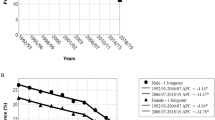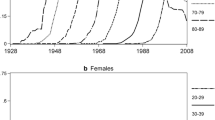Summary.
Objectives: Cultural and sex differences in smoking rates among countries indicate different phases of the smoking epidemic. Their background is summarized in a four-stage model based on the Rogers Theory of Diffusion of Innovations. First, to test predictions of the Rogers theory and, second, to test whether, according to the theory, today’s innovative process is smoking cessation, predicted by higher rates of cessation among the more highly educated and among men of all educational levels.
Methods: Data covered respondents older than 24 years from two Swiss Health Surveys (1997 and 2002). Logistic regression models were on lifetime smoking versus never-smoking, and on former smoking versus current smoking.
Results: Declining smoking rates in both sexes over time, measured by birth cohorts, indicate that the epidemic has peaked, but women of all educational levels and men of lower education still show high prevalence rates. The gap between higher-educated and lower-educated individuals is widening.
Conclusion: Smoking prevalence is expected to decline further, particularly among women and little educated men. The incidence of tobacco-related diseases in women is predicted to exceed that of men, owing to their lower cessation rates.
Zusammenfassung.
Die Epidemie des Rauchens in der Schweiz – eine empirische Überprüfung der Theorie zur Verbreitung von Innovation
Fragestellung: Zunächst wurden einzelne Aspekte der Theorie “Diffusion of Innovations” von Rogers, zusammengefasst in einem Vier-Stufen-Modell, getestet. Weiterhin wurde überprüft, ob die Aufgabe des Rauchens den Annahmen der Theorie folgt und ebenfalls als innovatives Verhalten verstanden werden kann. Dies würde mit höheren Aufgaberaten unter Personen mit einer formal höheren Bildung und unter Männern im Allgemeinen einhergehen.
Methode: Die Daten stammen aus zwei Wellen der Schweizerischen Gesundheitsbefragung (1997 und 2002). Die Analysen wurden auf die über-24-Jährigen begrenzt und basieren auf logistischen Regressionsmodellen mit Lebenszeitkonsum von Tabak und der Aufgabe des Tabakkonsums als abhängiger Variablen.
Ergebnisse: Die Raucherraten sanken in den letzten Jahren bei beiden Geschlechtern. Somit scheint der Höhepunkt der Epidemie insgesamt bereits überschritten. Zwei Gruppen, Frauen insgesamt und Männer mit einer geringeren formalen Bildung zeigen noch hohe Raucherprävalenzen. Die Kluft bei den Raucherraten zwischen den höheren Bildungsgruppen und weniger Gebildeten weitet sich aus.
Schlussfolgerungen: Es wird erwartet, dass sich die Raucherraten weiterhin verringern, dies besonders unter Frauen und bei Männern mit geringer formaler Bildung. Die Autoren gehen davon aus, dass die Inzidenz von tabakbedingten Erkrankungen unter Frauen zukünftig die der Männer übersteigen wird, da erstere in der Entwicklung zu Rauchstopps geringere Raten aufweisen als Männer.
Résumé.
Consommation de tabac en Suisse – la théorie de la diffusion de l’innovation à l’épreuve
Objectifs: Premièrement, vérifier la théorie de la diffusion de l’innovation de Rogers, qui repose sur un modèle en quatre phases. Deuxièmement, tester si le processus innovateur actuel est celui de l’arrêt du tabac, prédit par des taux d’arrêt plus élevés parmi les personnes avec un niveau élevé d’éducation et chez les hommes.
Méthodes: Les données ont été recueillies dans le cadre de l’Enquête suisse sur la santé (1997 et 2002) auprès de personnes de plus de 24 ans. Les analyses portent sur la consommation de tabac au cours de l’existence (au moins une fois vs. jamais, et ex-fumeurs vs fumeurs actuels).
Résultats: Les taux de consommation de tabac reculent chez les hommes et les femmes, indiquant que le pic de l’épidémie est passé. Dans la phase actuelle, en ce qui concerne l’arrêt du tabac, les hommes avec un niveau d’éducation bas et les femmes sont en retard par rapport aux hommes au niveau de formation élevé. Le fossé se creuse entre les personnes au niveau de formation élevé et celles au niveau de formation bas.
Conclusion: La prévalence de la consommation de tabac devrait continuer de baisser, en particulier chez les femmes et parmi les hommes de bas niveau de formation. Toutefois, comme le taux de consommation de tabac ne décline chez les femmes que depuis quelques années, l’incidence des maladies liées au tabac chez celles-ci devrait dépasser celle observée chez les hommes.
Similar content being viewed by others
Author information
Authors and Affiliations
Corresponding author
Rights and permissions
About this article
Cite this article
Kuntsche, S., Gmel, G. The smoking epidemic in Switzerland - an empirical examination of the theory of diffusion of innovations. Soz.-Präventivmed. 50, 344–354 (2005). https://doi.org/10.1007/s00038-005-4110-6
Received:
Accepted:
Published:
Issue Date:
DOI: https://doi.org/10.1007/s00038-005-4110-6




